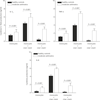Regulatory T cells in induced sputum of asthmatic children: association with inflammatory cytokines
- PMID: 22958596
- PMCID: PMC3463039
- DOI: 10.1186/2049-6958-5-1-22
Regulatory T cells in induced sputum of asthmatic children: association with inflammatory cytokines
Abstract
Background and objective: CD4+CD25+ regulatory T (Treg) cells play an essential role in maintaining immune homeostasis. In this study, we investigated whether the induced sputum (IS) pool and the function of CD4+CD25+ Treg cells are altered in asthma pediatric patients.
Methods: Treg activity was studied in the IS of 40 asthmatic children. CD3+ cells were analyzed for the expression of FoxP3 mRNA by real time reverse transcription-polymerase chain reaction (RT-PCR). IS cells from asthmatics and controls were stained for Treg markers and analyzed by flow cytometry. We also studied the ability of Treg cells to differentiate monocytes toward alternatively activated macrophages (AAM), and to suppress proinflammatory cytokines.
Results: (i) Mild and moderate asthmatics had significantly decreased expression of FoxP3/β-actin mRNA and decreased proportions of CD4+CD25highFoxP3+ cells compared to healthy children; (ii) patients with moderate asthma had even lower proportions of FoxP3 expression compared to mild asthmatic patients; (iii) monocytes cultured with Treg cells displayed typical features of AAM, including up-regulated expression of CD206 (macrophage mannose receptor) and CD163 (hemoglobin scavenger receptor), and an increased production of chemokine ligand 18 (CCL18). In addition, Treg cells from asthmatics have a reduced capacity to suppress LPS-proinflammatory cytokine production from monocytes/macrophages (IL-1, IL-6 and TNF-α).
Conclusion: Asthma pediatric patients display a decreased bronchial Treg population. The impaired bronchial Treg activity is associated with disease severity.
Figures




Similar articles
-
Transcriptional characteristics of CD4 T cells in young asthmatic children: RORC and FOXP3 axis.J Inflamm Res. 2011;4:139-46. doi: 10.2147/JIR.S25314. Epub 2011 Nov 11. J Inflamm Res. 2011. PMID: 22259252 Free PMC article.
-
CD4+CD25+Foxp3+ regulatory T cells induce alternative activation of human monocytes/macrophages.Proc Natl Acad Sci U S A. 2007 Dec 4;104(49):19446-51. doi: 10.1073/pnas.0706832104. Epub 2007 Nov 27. Proc Natl Acad Sci U S A. 2007. PMID: 18042719 Free PMC article.
-
Role of regulatory CD4+CD25+ Foxp3 T cells in bronchial asthma in Egyptian children.Egypt J Immunol. 2013;20(2):29-38. Egypt J Immunol. 2013. PMID: 24617045
-
[Role of Foxp3 expression and CD4+CD25+ regulatory T cells on the pathogenesis of childhood asthma].Zhonghua Er Ke Za Zhi. 2006 Apr;44(4):267-71. Zhonghua Er Ke Za Zhi. 2006. PMID: 16780646 Chinese.
-
An increased ratio of Th2/Treg cells in patients with moderate to severe asthma.Chin Med J (Engl). 2013 Jun;126(12):2248-53. Chin Med J (Engl). 2013. PMID: 23786933
Cited by
-
Transcriptional characteristics of CD4 T cells in young asthmatic children: RORC and FOXP3 axis.J Inflamm Res. 2011;4:139-46. doi: 10.2147/JIR.S25314. Epub 2011 Nov 11. J Inflamm Res. 2011. PMID: 22259252 Free PMC article.
-
Regulatory T cells mediated immunomodulation during asthma: a therapeutic standpoint.J Transl Med. 2020 Dec 2;18(1):456. doi: 10.1186/s12967-020-02632-1. J Transl Med. 2020. PMID: 33267824 Free PMC article. Review.
-
Clinical significance of sCD163 and its possible role in asthma (Review).Mol Med Rep. 2017 May;15(5):2931-2939. doi: 10.3892/mmr.2017.6393. Epub 2017 Mar 24. Mol Med Rep. 2017. PMID: 28350095 Free PMC article. Review.
-
Regulation of the development of asthmatic inflammation by in situ CD4(+)Foxp3 (+) T cells in a mouse model of late allergic asthma.Inflammation. 2014 Oct;37(5):1642-53. doi: 10.1007/s10753-014-9892-3. Inflammation. 2014. PMID: 24854160
-
The impact of vitamin D deficiency on immune T cells in asthmatic children: a case-control study.J Asthma Allergy. 2012;5:11-9. doi: 10.2147/JAA.S29566. Epub 2012 May 9. J Asthma Allergy. 2012. PMID: 22690128 Free PMC article.
References
-
- Akdis M, Verhagen J, Taylor A, Karamloo F, Karagiannidis C, Crameri R, Thunberg S, Deniz G, Valenta R, Fiebig H, Kegel C, Disch R, Schmidt-Weber CB, Blaser K, Akdis CA. Immune responses in healthy and allergic individuals are characterized by a fine balance between allergen-specific T regulatory 1 and T helper 2 cells. J Exp Med. 2004;199:1567–1575. doi: 10.1084/jem.20032058. - DOI - PMC - PubMed
LinkOut - more resources
Full Text Sources
Research Materials

